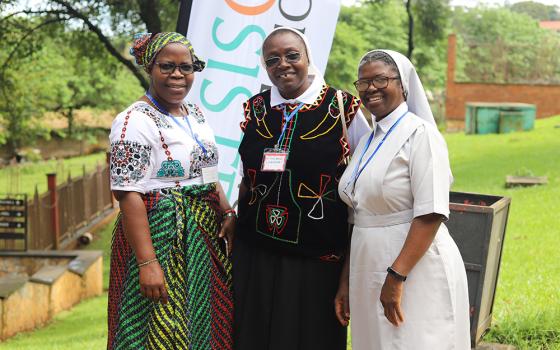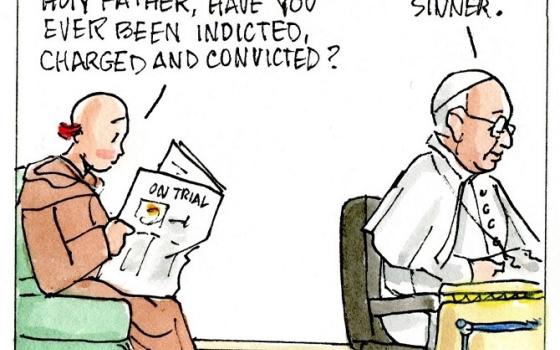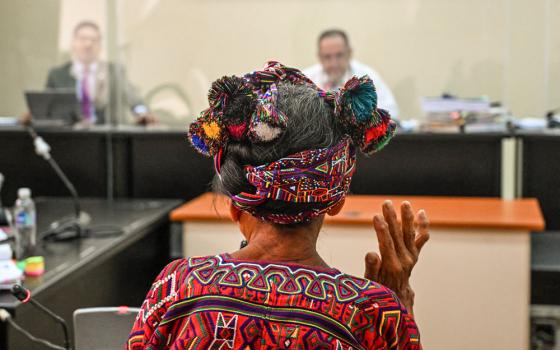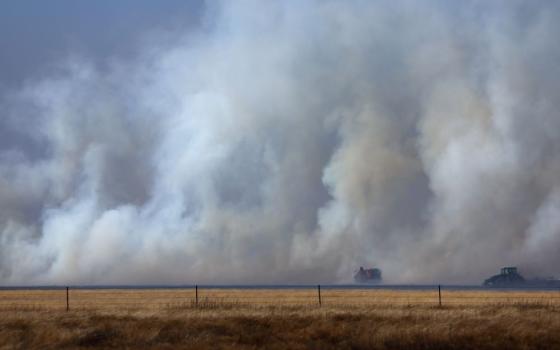
As the golden anniversary of the Second Vatican Council’s opening on Oct. 11, 1962, approaches, men ordained in the years bookending the council predominantly embrace “the spirit of Vatican II” as a wellhead for their lives and ministry even as other Catholics disparage that “spirit.”
At the same time, many of these “Vatican II priests” -- as researchers call them -- express concern that the iconic church windows thrown open by the council are being shuttered and latched. They raise concerns about church leadership, ecumenical apathy, a collapse of collegiality, the role of women, liturgical reform and more.
“Sometimes I think the Second Vatican Council is the church’s best-kept secret,” said Fr. David Pettingill, a retired priest of the San Francisco archdiocese who is still active in retreat work and teaching courses on the council for lay ecclesial ministers.
“What I see is a concerted effort to pull back from Vatican II with a party line, and that party line is that the council was simply in continuity with the church’s teaching and that it simply evolved,” said Pettingill, a former pastor, college seminary teacher and high school administrator who was ordained in 1962.
“However, when you take that approach, and it can be a valid one,” he added, “you also have to ask another question, if you are going to be historically accurate: What did that council do for the church?
“Unless you want to say it was a waste of time, there are some things that happened there that had never happened in the 20 other ecumenical councils, and the documents produced are in a different literary form, and they are the consensus of the largest number of bishops throughout the world ever assembled, and they were taking a fresh look at the church because John XXIII said, ‘We are going to have aggiornamento. We are going to bring the church up to date.’
“So I find the party line,” Pettingill said, “a real admission of that fact that we are pulling back” from ongoing renewal. “I find that very sad.”
Many interviewed pointed to the tension between interpreting the council as an inauguration of an open and collegial church versus viewing it as “the end of a process, not the beginning,” in the words of Jesuit Fr. Thomas Reese.
 Ordained in 1974, Reese entered the Jesuits the year the council opened. “We were locked up in the seminary and hardly knew it was going on,” he laughed. “We had no access to newspapers or TV or magazines -- or to The New Yorker, which, of course, was running the pieces by F.X. Murphy.”
Ordained in 1974, Reese entered the Jesuits the year the council opened. “We were locked up in the seminary and hardly knew it was going on,” he laughed. “We had no access to newspapers or TV or magazines -- or to The New Yorker, which, of course, was running the pieces by F.X. Murphy.”
Redemptorist Fr. Francis X. Murphy used the pseudonym Xavier Rynne to file behind-the-scenes reports on the council proceedings.
“Somehow or another I heard about the council, and two of us went to the superior and asked for permission to have copies of the documents of Vatican II. He had a meeting with his consultors to decide whether or not we could have copies. The decision was that the two of us could have them because we had asked, but they would not be made generally available to the other seminarians.
“Within a month they were mandatory reading,” Reese laughed again.
“Even though there were struggles and arguments and fights” during the council, Reese said, “there was a feeling that history was on the side of the progressives and that we were moving forward, that it was pretty much unstoppable and things were going to get better in the church year after year.”
Reese said, “This pretty much stopped with the papacy of John Paul II,” who saw “the documents of Vatican II as what was important, not the spirit.”
Currently a senior fellow at the Woodstock Theological Center at Georgetown University in Washington, Reese was a source of concern for the Vatican during his seven years as editor in chief of the Jesuits’ weekly magazine, America. He resigned that post in 2005 following curial criticism of his openness to exploring sensitive church topics, from same-sex marriage and stem cell research to reception of Communion by Catholic politicians who support legal abortion.
Before becoming pope, Cardinal Joseph Ratzinger, as head of the Congregation for the Doctrine of the Faith, and Pope John Paul II “put their interpretation on the documents ... and often it was the conservative, minority interpretation of the council,” Reese said.
“Today the fear is not only that the brakes have been put on, but that the gearshift has been put into reverse. We see changes in the areas of collegiality, liturgy, and ecumenism, where we cannot even call Protestant communities churches any more.”
Meanwhile, critics of “the spirit of Vatican II” charge that it is played like a get-out-of-doctrinal-orthodoxy-free card.
Ratzinger, now as Pope Benedict XVI, forwards the argument for a “hermeneutic of continuity” that underscores interpretation of the council documents themselves.
Catholic pundits such as Russell Shaw are explicit. In a 2009 essay titled “Vatican II and the Culture of Dissent,” he argues that “far and away the biggest building block of that culture [of dissent] was the 'spirit of Vatican II'.”
“For progressives,” Shaw wrote, “the beauty of the spirit of Vatican II was that it permits them to dismiss the council's teaching while at the same time claiming to champion the council.”
“When judging postconciliar developments … it is necessary to consider a fundamental question: Was the Second Vatican Council really the sharp break with the church's past that the 'spirit of Vatican II' rhetoric claimed?” wrote Shaw He then quotes Dominican theologian Father Yves Congar as deploring “the 'rather simplistic practice' of interpreting the council as if it had been 'an absolute new beginning, the point of departure for a completely new Church'.”
Continued Shaw, “Against claims of a revolutionary break with the past, the eminent theologian declared he was 'anxious to stress the continuity of tradition.' Vatican II, he said, was 'one moment and neither the first nor the last moment in that tradition'."
 Such postulations leave those such as Fr. J. Severyn Westbrook shaking their heads: “If the church is essentialist, we know everything and there is nothing more to be known and all matters are settled. People have to learn what is established truth. It’s all over. We just have to carry it out. And I think that is pretty much the reigning vision today.”
Such postulations leave those such as Fr. J. Severyn Westbrook shaking their heads: “If the church is essentialist, we know everything and there is nothing more to be known and all matters are settled. People have to learn what is established truth. It’s all over. We just have to carry it out. And I think that is pretty much the reigning vision today.”
Ordained in 1962 for the Spokane, Wash., diocese, Westbrook continued, “In an existentialist church, you listen and pay attention to how the spirit is moving among the people, especially in communities of faith. You learn from that. The church has to be a living, breathing, feeling, praying organism. Are we to be an organism or are we to be an organization?”
Westbrook admitted, “At times I am very discouraged. It is like the people in charge -- whom I generally call the temple authorities -- are winning. They are winning by attrition. And they have carefully formed what is coming in the future.”
He recalled a 1982 presentation on the need for married priests that he was asked to make to the bishops of the Pacific Northwest. “I was surprised that not one of them took issue,” he said. “Some were even enthusiastic. There was a virtual consensus.”
However, “I have long been perplexed why the topic never saw its way to the agenda of the national bishops’ conference. It certainly begs the question to what degree the bishops may exercise collegiality or even be in charge of their own agenda.”
Open, candid dialogue “is not the way it is anymore,” charged Westbrook, a retired pastor, scholar and and Newman chaplain. “The positions have been determined and they are allowed to vote yes. It is closed. Are we to be a monolith or are we to be like human beings who think and feel? And that means we can disagree, and maybe we can come to a consensus. But we have to listen to one another.”
“I have not lost hope and I trust in the Holy Spirit,” he added, “but the game is rigged.”
Westbrook, Reese and Pettingill are what sociologists studying church trends term “Vatican II priests.” A major study of priests and their ministry scheduled for release in April defines the term as men born between 1943 and 1960.
Commissioned by the National Federation of Priests’ Councils and implemented by the Center for Applied Research in the Apostolate (CARA) based at Georgetown, the research contends that priests formed in the immediacy of Vatican II tend to view priesthood, ministry and church differently in many respects than older and younger men.
Among other things, these Vatican II priests see themselves more as “servant leaders” within community than as “a man set apart” as do the earlier “pre-Vatican II priests” and more recent “post-Vatican II priests” and “millennial priests.”
Vatican II priests are more likely to support the principle of consulting lay leaders and their congregations.
Titled Same Call, Different Men: The Evolution of the Priesthood since Vatican II, the new study also reports that men ordained more recently tend to stress church orthodoxy and rate themselves happier in ministry than Vatican II priests. They also feel episcopal and papal support more strongly than Vatican II men.
In an impassioned December 2010 essay titled “Reflections on an Ordination Golden Anniversary,” a well-known Australian priest, Fr. Eric Hodgens, declared, “We took Vatican II to heart. We changed from being priests called and consecrated by God to being presbyters called and ordained by the church -- the People of God.”
“We are the Gaudium et Spes priests,” Hodgens wrote, alluding to the council’s Pastoral Constitution on the Church in the Modern World, which provides a theological framework calling the church to global involvement in issues from social justice and technology to economics and ecumenism.
A priest of the Melbourne archdiocese, Hodgens criticized what he sees as troubling post-Vatican II trends in ecumenism, in episcopal timidity and compliance, in church leadership’s lack of scientific acumen, in close-ended theological and scriptural scholarship, in ill-conceived liturgical regression, in lack of collegiality, transparency and open discussion, and in sexual mores “being promoted to the top shelf” of church attention.
“Discordant decisions were coming down from the pope,” Hodgens wrote. “Priestly celibacy, despite being highly contentious, was reasserted by Paul VI in 1967 without discussion. In 1968 Humanae Vitae was a shocking disappointment. Most of us never accepted it. Paul VI began appointing bishops opposed to the council’s ethos. ... The whole trend was demoralizing.”
However, Hodgens also emphasized what the CARA study found and NCR interviews confirmed: Vatican II priests are generally very satisfied with their lives and ministry, even if not at the same level as older and younger groups.
Hodgens calls the phenomenon “being happy in their own patch.”
 Ordained in 1969, Fr. Gary Lombardi is happy in his “patch,” St. Vincent de Paul Parish in Petaluma, Calif., but he clearly could be happier with where he sees the church headed.
Ordained in 1969, Fr. Gary Lombardi is happy in his “patch,” St. Vincent de Paul Parish in Petaluma, Calif., but he clearly could be happier with where he sees the church headed.
“In many ways things have reverted to the authoritarian, hierarchical, institutional model. Things are much more top-down,” he explained. “Everything seems to come from Rome. Bishops are appointed without much consultation with bishops of the region. There is a kind of emphasis on orthodoxy and fidelity and the magisterium and loyalty to the Holy Father that is the same as before the council.”
There has been a return to “rigidity” and an emphasis on “people measuring up to the church rather than the church ministering to people,” said Lombardi, who headed the Santa Rosa diocese’s clergy education office for 16 years. “At times I have seen good people suffer because of that rigidity.”
Lombardi recalls struggling in the final years of his seminary training with “if I was going to serve the church or if I was going to serve the people.”
“Then it struck me,” he said. “The church is the people of God. Vatican II did that.”
While saying that the church “certainly needs a governing authority,” Lombardi stressed that Vatican II underscored a church “in touch with the lives of people” and open to “collegiality and consultation in matters of church life and teaching.”
“That was a fundamental dynamic operative at the council,” he said. It led to “a kind of greater ease” with which pastors like himself could “look directly into the people’s lives” and “help church teaching make sense to them.”
The Gaudium et Spes generation does see shifts in pastoral perspective.
Lombardi stated simply, “There seems to be an increasing clericalism on the part of the younger clergy.”
And with official church encouragement, Pettingill pointed out. “It does seem to me that in certain documents that the priest is gradually being exalted above the people he is going serve -- things like only the ordained being allowed to clean sacred vessels, the emphasis on priestliness to the point a man is almost put on a pedestal. And that is dangerous for both the priest and the people because we are all human, and it is that humanity that makes us able to deal with one another.”
 Others, including Fr. Norbert Dlabal, agreed. “The new generation of priests does seem to want to maintain a distinction between priesthood and laity,” said Dlabal, pastor of Our Lady of Perpetual Help Parish in Goodland, Kan.
Others, including Fr. Norbert Dlabal, agreed. “The new generation of priests does seem to want to maintain a distinction between priesthood and laity,” said Dlabal, pastor of Our Lady of Perpetual Help Parish in Goodland, Kan.
The new CARA study echoes his language. The most recently ordained priests “feel strongly about ... making a clear distinction between themselves and the laity,” write the authors.
According to the 2009-2010 research, more than two-thirds of millennial priests -- those ordained after the midpoint of John Paul II’s 1978-2005 papacy -- agree “strongly” with the statement: “Ordination confers on the priest a new status or a permanent character which makes him essentially different from the laity within the Church,” compared to 48 percent of both pre- and post-Vatican II priests and 36 percent of Vatican II priests.
Although Dlabal, a former vocations director for the Salina, Kan., diocese and a missioner in Peru for five years, said he tries “to make light of it,” he questioned Catholics “impressed by appearances” who grant “nobility” to “any cleric committed to wearing black.”
“Authenticity? What is that?” asked Dlabal, who was ordained in 1972. “Maturity, generosity, wisdom, kindness, self-sacrifice, patience, personal responsibility, long-suffering, friendship, respect and love? What are those things? ... Just put on a cassock with a Roman collar and you are a faithful, loyal, docile, reliable servant. Put on another color of shirt and you are suspect. Leave the old cassock in the closet and put on a colored shirt and you are a traitor.”
He also noted, “Younger priests really do not feel the need to collaborate all that closely. There is kind of a general idea that they are the leaders of the parish and everyone else can dance to their music.”
Eschewing the Vatican II “servant-leader” model of priesthood in favor of a more authoritarian one flies in the face of both of the spirit of Vatican II and the Catechism of the Catholic Church, Msgr. Ralph Kuehner charged in recent reflections on his 60 years as a priest.
The catechism, he said, “directs the ministerial priests to serve the priesthood of the laity: ‘While the common priesthood of the faithful is exercised by the unfolding of baptismal grace ... the ministerial priesthood is at the service of the common priesthood.’ ”
Kuehner, a high-profile social justice advocate in the Washington archdiocese, said he worries that “so many aspects of our church reflect a monarch rather than a servant.” He told the story of his 3-year-old niece who, when asked about a Mass at which a bishop officiated, said she saw “a king with a yellow stick.”
The priest added a “personal vision for the future of the church” that includes encouraging church service for “priests who have left to be married” and expanding priestly ordination to married men and to women.
Other Vatican II priests also support this call to openly discuss women’s role in the church as well as other issues, from gay and lesbian Catholics to fertility science.
“To just say that we do not discuss these things” does not work, Westbrook said.
Reese said, “The church simply has not figured out how to deal with an educated laity. It still thinks that all it has to do is for the bishops and the Vatican to act like parents of teenage children. They think that if they just shout a little louder the children will behave. They say things the equivalent of ‘not in my house’ or ‘you won’t because I said so.’ Anyone with teenage children knows how successful that strategy is.”
He said, “What the church needs to develop is a new style of teaching the Gospel that is understandable by the people in the 21st century. You don’t just repeat formulas from the 13th century.”
Pettingill strives for that in his classes for lay Catholics preparing for parish ministry. “I am going to do everything I can to make the riches of Vatican II known. Theology is supposed to be creative,” he told NCR. “For example, in the New Testament each of the Gospel authors retells and re-tailors his message, each with a different emphasis, to meet the needs of his hearers.”
Too often, he commented, “theology now seems to be an exegesis of papal documents. I wonder where the creativity is. If we do not have it, we do not grow.”
Westbrook said he sees as institutional desertion of dialogue. “I have had priests actually tell me that collegiality needs to be suppressed,” he said.
“There are people like me who are still trying to live in the spirit of Gaudium et Spes,” he said, “and there are people who are trying to put an end to it. From their point of view, the church had been in grand shape and, for reasons unknown, even whimsical, John XXIII turned everything upside down. A certain constituency feels that the old should be restored. No doubt. No hesitation. Authority will take care of everything.”
One example of misguided use of authority that surfaced as a frequent irritant for Vatican II priests is the development and implementation of the new English translation of the Roman Missal.
Dlabal views the translation as an “example of making an issue of a non-issue for some other purpose” -- that purpose being “to let the church know who is in charge” and to vaporize the translation growing from the Second Vatican Council.
Pettingill, who taught high school English classes as a young priest, pointed out, “No one asked God’s people if they would like a new English translation. Fact two, or maybe this is more of a suspicion, local bishops were not consulted in the sense of being asked if they felt it was appropriate at this particular time. Thirdly, if you have any dealings with teaching English, you realize the translation is not English. It is a Latinized English, which is cumbersome and very difficult to proclaim.”
Disdain for dialogue and contempt for consultation repeatedly draw the ire of the men educated and ordained within the short shadow of the Second Vatican Council. During the council, they say, the operative formula for seeking truth was the pope working in concert with the college of bishops.
They would agree with a young theologian-consultant to the council who wrote in 1963, “The formulation of liturgical laws for their own regions is now, within limits, the responsibility of the various conferences of bishops. And this is not by delegation from the Holy See, but by virtue of their own independent authority.”
According to biographer John L. Allen Jr., that theologian, Fr. Joseph Ratzinger and future Pope Benedict XVI, would also write during the days of the council, “For many people today the church has become the main obstacle to belief. They can no longer see in it anything but the human struggle for power, the petty spectacle of those who, with their claim to administer official Christianity, seem to stand most in the way of the true spirit of Christianity.”
And that true spirit of Christianity, Vatican II priests will say, was -- and is -- illuminated brightly by “the spirit of Vatican II.”
[Dan Morris-Young is an NCR West Coast correspondent.]
In this package:
- Vatican II priests still embrace council's model despite reversals
- Jesuit advocates 'do-it-yourself church'
- Study of US priests: Aging is 'most striking trend'
[Editor's Note: An earlier version of this story incorrectly attributed a quote to Russell Shaw. The mistake has been replaced with the proper quote from Mr. Shaw. NCR regrets the error.]




